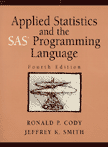Applied Statistics and the SAS Programming Language, Fourth Edition

Applied Statistics and the SAS Programming Language, Fourth Edition | 
|
by Ron Cody and Jeffrey K. Smith
Complete with numerous examples, this book is a leading guide for performing statistical analyses. The new user, with an introductory-level understanding of the SAS System, will find this an easy-to-read approach to basic statistics and SAS programming. All experienced users will find the numerous examples and statistical techniques a handy reference tool. Benefit from the following topics covered in detail: effective questionnaire design for data collection and analysis, use of t-tests and nonparametric comparisons, how to subset and combine data from several files, computation of one-way and n-way analysis of variance, and restructuring SAS data sets using arrays. This book has been revised to include more information about analyzing categorical data, factor analysis, logistic regression, and psychometrics.
437 pages.
Replaces: Applied Statistics and the SAS Programming Language, Third Edition;
Also Recommended: Categorical Data Analysis Using the SAS System; A Step-by-Step Approach to Using the SAS System for Factor Analysis and Structural Equation Modeling; The Little SAS Book: A Primer; SAS System for Regression, Second Edition; SAS Procedures Guide, Version 6, Third Edition; SAS/STAT User's Guide, Version 6, Fourth Edition, Volumes 1 and 2; SAS Software: Changes and Enhancements, Release 6.11; SAS/STAT Software: Changes and Enhancements through Release 6.12; SAS Software: Changes and Enhancements, Release 6.10; SAS Technical Report P-252, SAS Software: Changes and Enhancements, Release 6.09;
To order SAS Institute Publications, call SAS Institute book sales at 1-800-727-3228. (Note: This toll-free number is for ordering books in the U.S. only.) You may also contact book sales by E-mail at sasbook@unx.sas.com.
To order SAS Institute Publications, contact your local SAS office. International orders sent to the U.S. office will be faxed to the appropriate SAS Subsidiary or Distributor office. Pricing, delivery, and terms for all international documentation orders are determined by each local office.